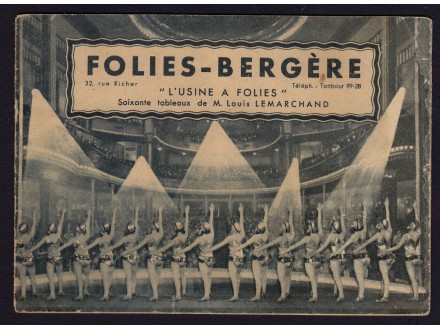kabare Folies Bergere - program c.1930
| Cena: |
| Želi ovaj predmet: | 6 |
| Stanje: | Polovan sa vidljivim znacima korišćenja |
| Garancija: | Ne |
| Isporuka: | Pošta Post Express |
| Plaćanje: | Tekući račun (pre slanja) PostNet (pre slanja) |
| Grad: |
Beograd-Stari grad, Beograd-Stari grad |
Godina : 1931 - 1940.
Detaljno stanje: Dobro
Kulturno dobro: Predmet koji prodajem nije kulturno dobro ili ovlašćena institucija odbija pravo preče kupovine
11 x 15,5 cm
prospekt
Folies Bergere je kabare muzička sala, smeštena u Parizu u Francuskoj. Smešten na 32 Rue Richer u 9. Arondissementu, Folies Bergere sagradio je arhitekta Plumeret kao operu. Otvoren je 2. maja 1869. godine kao Folies Trevise, uz laganu zabavu koja uključuje operete, komičnu operu, popularne pesme i gimnastiku.
------------------------------------
The Folies Bergère is a cabaret music hall, located in Paris, France. Located at 32 Rue Richer in the 9th Arrondissement, the Folies Bergère was built as an opera house by the architect Plumeret. It opened on 2 May 1869 as the Folies Trévise, with light entertainment including operettas, comic opera, popular songs, and gymnastics. It became the Folies Bergère on 13 September 1872, named after nearby Rue Bergère. The house was at the height of its fame and popularity from the 1890s` Belle Époque through the 1920s.
Revues featured extravagant costumes, sets and effects, and often nude women. In 1926, Josephine Baker, an African-American ex-patriate singer, dancer and entertainer, caused a sensation at the Folies Bergère by dancing in a costume consisting of a skirt made of a string of artificial bananas and little else.
The institution is still in business, and is still a strong symbol of French and Parisian life.
Located at 32 Rue Richer in the 9th Arrondissement, the Folies Bergère was built as an opera house by the architect Plumeret. The métro stations are Cadet and Grands Boulevards.
It opened on 2 May 1869 as the Folies Trévise, with light entertainment including operettas, opéra comique (comic opera), popular songs, and gymnastics. It became the Folies Bergère on 13 September 1872, named after a nearby street, Rue Bergère (`bergère` means `shepherdess`).
In 1882, Édouard Manet painted his well-known painting A Bar at the Folies-Bergère which depicts a bar-girl, one of the demimondaines, standing before a mirror.
In 1886, Édouard Marchand [fr] conceived a new genre of entertainment for the Folies Bergère: the music-hall revue. Women would be the heart of Marchand`s concept for the Folies. In the early 1890s, the American dancer Loie Fuller starred at the Folies Bergère. In 1902, illness forced Marchand to leave after 16 years.
In 1918, Paul Derval (1880–1966) made his mark on the revue. His revues featured extravagant costumes, sets and effects, and `small nude women`. Derval`s small nude women would become the hallmark of the Folies. During his 48 years at the Folies, he launched the careers of many French stars including Maurice Chevalier, Mistinguett, Josephine Baker, Fernandel and many others. In 1926, Josephine Baker, an African-American ex-patriate singer, dancer and entertainer, caused a sensation at the Folies Bergère in a new revue, La Folie du Jour, in which she danced a number Fatou wearing a costume consisting of a skirt made of a string of artificial bananas and little else. Her erotic dancing and near-nude performances were renowned. The Folies Bergère catered to popular taste. Shows featured elaborate costumes; the women`s were frequently revealing, practically leaving them naked, and shows often contained a good deal of nudity. Shows also played up the `exoticness` of people and objects from other cultures, obliging the Parisian fascination with the négritude of the 1920s.
In 1926 the facade of the theatre was given a complete make-over by the artist Maurice Pico . The facade was redone in Art Deco style, one of the many Parisian theatres of this period using the style.
In 1936, Derval brought Josephine Baker from New York City to lead the revue En Super Folies. Michel Gyarmathy , a young Hungarian arrived from Balassagyarmat, his hometown, designed the poster for En Super Folies, a show starring Josephine Baker in 1936. This began a long love story between Michel Gyarmathy, Paris, the Folies Bergère and the public of the whole world which lasted 56 years. The funeral of Paul Derval was held on 20 May 1966. He was 86 and had reigned supreme over the most celebrated music hall in the world. His wife Antonia, supported by Michel Gyarmathy, succeeded him. In August 1974, the Folies Antonia Derval passed on the direction of the business to Hélène Martini, the empress of the night (25 years earlier she had been a showgirl in the revues). This new mistress of the house reverted to the original concept to maintain the continued existence of the last music hall which remained faithful to the tradition.
Since 2006, the Folies Bergère has presented some musical productions with Stage Entertainment like Cabaret (2006–2008) or Zorro (2009–2010).
Josephine Baker
Programme des folies Bergère - revue 1930`s
MOLIM CENJENE KUPCE DA ISPOSTUJU PRAVILNIK(ROKOVE) LIMUNDO-KUPINDO TIMA.
ne dajem nikakve popuste.
izlozene cene su KONACNE, bez obzira na kolicinu
NE RAZNOSIM PRODATU ROBU - OVO VAZI I ZA BEOGRAD.
licno preuzimanje predmeta na mojoj adresi (ispred zgrade), posle 18h
naravno, u roku koji se dobije posle prodaje.
placanje na tekuci racun u POSTI - POSTANSKA STEDIONICA
INO KUPCI -- paypal (+5%) (pitati za postarinu)
INTERNATIONAL BUYERS WELCOME
IF YOU HAVE ANY QUESTION REGARDING CONDITION,SHIPPING AND PRICING PLEASE EMAIL US BEFORE YOU BID. THANK YOU !
NOVAC U PISMU - NE PRIMAM.
slanje POSTEXPRESOM (ili VREDNOSNO PISMO)
ako stoji `besplatna dostava`(pored broja pregleda) onda VAZI SAMO ZA SRBIJU
POUZECEM -- N E S A L J E M
komunikacija iskljucivo preko limundo-kupindo poruka
slike se najbolje vide kada se klikne na `Slika u punoj veličini`
Predmet: 66578497

















